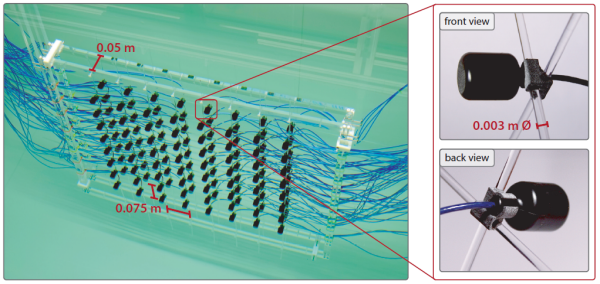Recording Surface
The sensors and sources for the WaveLab were developed in close collaboration with external pageProf. Michael Haberman's groupcall_made at the Walker Dept. of Mech. Eng., UoT at Austin. The main requirements for the recording surface are: mathematically-closed, but acoustically transparent, and a flat sensitivity in the 0-20 KHz range.
The custom-built sensing element (a hydrophone) consists of a cylindrical, hollow, piezoelectric element, polarized in the radial direction. Rigid end-caps seal the inside of the air-filled cylinder. A layer of epoxy resin protects the element from mechanical damages and seals it against water. The sensors are operated below resonance. The final design of a single-element hydrophone was chosen mainly because of its lower scattering cross section and more uniform directivity.
Since immersive boundary conditions require both pressure and normal particle velocity recordings, hydrophones are staggered in the normal direction of the planar recording surface to obtain an estimate of the normal particle velocity. The surface consists of two arrays with 8 x 8 hydrophones each (i.e., 128 hydrophones per face). With an in-plane (Nyquist) spacing of 0.075 m, the extent of each array is 0.525 x 0.525 m. The 2 arrays are separated by 0.05 m in the normal direction.
To mitigate scattering from the mounting structure of the arrays, materials that exhibit low impedance contrasts relative to water were used. To guarantee long-term stability in water, a compromise between the (amount of) material and its scattering properties had to be found. In each array, a lattice of 3 mm-thick rods, made from acrylic glass (PMMA), is held under tension by a robust PMMA frame. The hydrophones are connected to the lattice with 3D-printed polycarbonate clips.
Related Publications:
Acoustic immersive experimentation through real-time control of boundary conditions
Börsing, N.
PhD Thesis, ETH Zürich (2020)
Immersive wave experimentation: linking physical laboratories and virtual simulations in real-time
Becker, T. S.
PhD Thesis, ETH Zürich (2020)
external pagehttps://doi.org/10.3929/ethz-b-000410579call_made
Acoustic transducer design for active reflection cancellation in a finite volume wave propagation laboratory
Willard, E.
MSc Thesis, The University of Texas at Austin (2019)
external pagehttps://repositories.lib.utexas.edu/handle/2152/75829call_made

